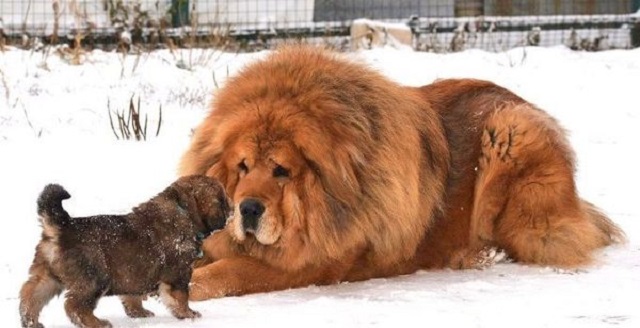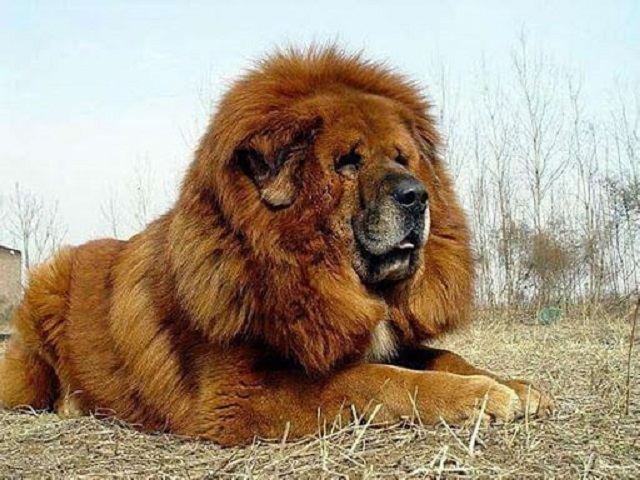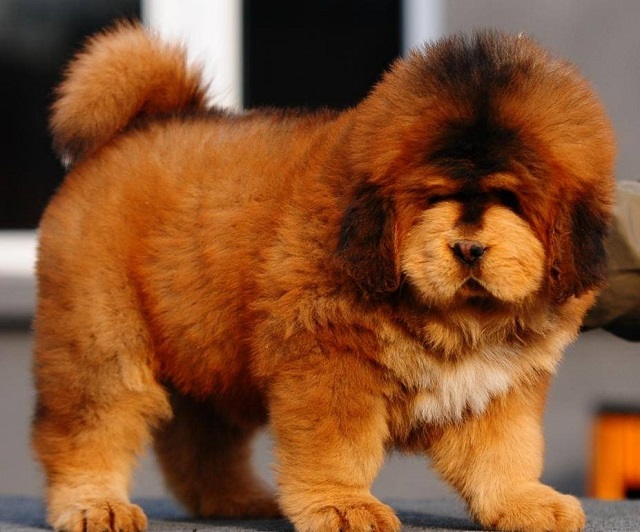Tibetan Mastiff – Information, characteristics, how to raise
The Tibetan Mastiff is one of the giant dog breeds native to Tibet, China. The breed has almost retained its original genes and has not been crossed with any dog breeds. To own this breed, you have to spend as much as you would on a high-end luxury car. So what makes them so expensive and still attracts many buyers? Let's learn about the origin, characteristics, selling price and where to buy the famous Tibetan Mastiff in Ho Chi Minh City, Hanoi
1. History and Origin of Tibetan Mastiff
Tibetan Mastiff, also known as Tibetan Mastiff, the English name Tibetan Mastiff. This is a dog breed bred and trained by Tibetans. They are used for grazing and to protect the herds of the indigenous peoples of the Himalayas. The dog was also sent to guard monasteries in the mountains of Tibet. Bigger than a wolf, stronger than a deer, quicker than a deer.
About 1,500 years ago, the Tibetan Mastiff was divided into two breeds: the Do-Khyi (medium-sized, aggressive dog) and the Tsang-Khyi (a large, docile dog dedicated to guarding temples).
The breed is native to the Tibetan Plateau in the Himalayas. The Tibetan Mastiff is considered the ancestor of the mastiff breeds that appear around the world today.
In 1847, a giant mastiff appeared in Tibet. The first Tibetan Mastiff was brought to Europe as a gift to the Queen of England. Immediately, with their tall appearance and stronger strength than the big dancers, they overwhelmed the Europeans.
In 1874, Prince Edward went on to introduce two Tibetan mastiffs into the UK. This was a boom time for the breed. They were nearly extinct in Europe during World Wars I and II.
It was not until 1976 that the Tibetan Mastiff was reintroduced and bred here. This breed is growing in popularity in Canada and the United States. Today, the appeal of Tibetan clams has never cooled.
Due to their high prices and high popularity, they are at risk of crossing with many other dog breeds. Create commercialization and sell them cheaper than purebred dogs. However, purebred Tibetan Mastiffs can still be found in temples on the Qinghai-Tibet Plateau.
2. Appearance characteristics of Tibetan clams
As soon as you see the Tibetan Mastiff, you will be attracted by its huge appearance and stronger physique than any other dog. The breed has the following prominent appearance characteristics:
Height and weight
The Tibetan Mastiff has the largest body of any dog. Each adult weighs up to 110kg and is about 1.2m tall, far exceeding the Alaskan giant.
At present, the size of an adult Tibetan Mastiff is usually between 70-80 cm and the weight is between 60-90 kg. Depending on the breeder's care regimen, the weight may be more.
Physical characteristics
The Tibetan Mastiff breed has a well-proportioned body with strong, muscular shoulders, chest, thighs and buttocks hidden behind a ruffled coat. Their four legs are like four pillars, steady and down-to-earth.
The tails of this breed are long and large, and they often stand still, drooping or arched back. Their tail feathers are very soft, although somewhat fluffy.
Despite its huge size, Tibetan clams can reach the limit of speed when running and jumping, far surpassing wolves. Therefore, Western explorers described this breed as "bigger than wolves, stronger than tigers, and faster than deer".
Head

Tibetan Mastiff has a pair of small, slightly slanted eyes, which are very sharp. Their eyes are mostly dark brown or black. Tibetan clams have big and long ears that always hang down to their cheeks.
In general, the face of this breed is usually quite cute. When angry, they growl, baring their teeth like a very scary beast. This is a way for prey to cower and not attack them.
Fur
The most prominent feature of the Tibetan Mastiff is its ruffled coat, which is like a body armor. The long, thick coat acts as a full body covering. Usually the inner coat is short and soft, like wool, while the outer coat is long, stiff and shaggy.
Due to their thick coat, Tibetan clams are not afraid of the cold and are very adaptable to the harsh climate conditions of the Himalayas. This breed has a variety of coat colors, the more popular ones are: dark brown, black yellow, reddish brown, orange, brown, black, gray and so on. The neck hair is longer, thicker and shaggier than the body hair.
3. The characteristics of Tibetan clams
While Tibetan Mastiffs can be intimidating at first sight due to their large size, they can be a lot of fun to keep. The breed has the following common characteristics:
Loyalty
This is the most prominent character of Tibetan mastiffs. They are always absolutely loyal to their masters. They only worship a single master who has been cared for, raised and trained since childhood.

This breed is ready to fight the enemy to protect the owner, even in danger. This is why many nomads use Tibetan clams for protection while traveling.
Especially Tibetan clams, they always listen to their masters. Any stranger will be a target, so don't adopt when the dog is an adult, as it can be dangerous, especially if you don't have experience training and keeping a Tibetan Mastiff.
Ferocious and dangerous
The Tibetan clam is considered the king of the prairie. They are aggressive and move faster than lions and tigers. Therefore, the breed makes it into the top ten most dangerous dog breeds in the world.
Once upon a time, a Tibetan mastiff killed 37 wolves in order to protect its owner's livestock. The aggressive instincts and great strength can pose a danger to the owner if not trained.
Stubborn, always vigilant

In addition, Tibetan Mastiffs are always on high alert for everything around them, and sometimes show an exaggerated attitude. At night, they always prick up their ears to listen to every movement, detect all strange sounds and signal to their masters.
With good training, this breed becomes friendly, gentle and gets along well with people. However, only to a certain extent, so farming Tibetan clams requires care.
4. Some common diseases of Tibetan Mastiff
Health problems can occur with any pet dog breed, even when well cared for. Tibetan Mastiffs are oversized and healthy, but they can sometimes suffer from the following common diseases:
Elbow bone disease
The disease is common in large animals. The cause of the disease is often due to excessive exercise, calcium deficiency, or genetics. When the bones and joints become loose, it is difficult for the dog to move around.
Infectious tracheitis
This disease is very common in young Tibetan Mastiffs. Because they don't know how to keep warm, they are prone to colds and bronchitis when the weather changes suddenly. While the disease is not dangerous, it can affect a dog's health as it matures.
Thyroid disease
Thyroid disease leads to low immunity of Tibetan Mastiff. Increased thyroid hormone production can lead to fatigue, lethargy, and lack of flexibility. However, the disease is treatable with medication and must be maintained for life.
Hip dysplasia
The etiology of the disease is often related to genetics and unscientific diet. When pet dogs eat too much and are inactive, they will gain weight uncontrollably. This inadvertently puts stress on the bones of the body, leading to hip dysplasia.

5. How to Breed and Train a Tibetan Mastiff
If you want to care for the healthy growth of Tibetan Mastiff, you need to pay attention to the following issues:
Tibetan Clam Diet
You need to pay attention to a reasonable diet that provides a full range of substances: calcium, protein, minerals, vitamins and some essential nutrients.
- Dogs of 2-4 months: Because the dog is small, it only needs ground peanuts mixed with rice. Combine with dry food. You should feed your dog three meals a day, alternating between giving the dog milk.
- Dogs aged 4 to 8 months: adequately supplement chicken, beef, pork and animal offal. Add vegetables, eggs and dry food. At this point, you should only eat 2 meals per day based on your body weight.
- For dogs 8 to 12 months: Feed a variety of meats, bones, chicken neck bones, etc. Feed your dog 1 main meal and 1 treat to ensure an adequate supply of calcium and protein.
- Dogs over 1 year old: Tibetan Mastiffs over 1 year old need to eat at least 1 kg of food every day. The amount of food gradually increases with weight and age.
Note: Do not feed Tibetan clams with old, raw, unprocessed foods. This dog will not eat fish, fatty meat, or high-fat foods. You need to feed them with a clean tray and change the water daily. At the same time, don't force the dog to eat too full or too hungry.
Tibetan mastiff living conditions
Tibetan mastiffs are suitable for living in prairie areas. The airy, spacious space creates conditions for them to play and run freely. Of course, you can have puppies with your family, but be sure to have a large yard. The garden of the house should be fenced off so that the dog does not pose a danger to outsiders.
Tibetan clams have a hard time adapting to Vietnam's hot and humid climate because of their thick feathers. This variety grows well only in the shade or indoors where the temperature is not too hot. When the weather is too hot, you can let your dog live in an air-conditioned room.
Proper care of your dog's coat and daily hygiene
Tibetan clams have super thick fur, which is quite unfavorable for living in Vietnam. In order for the coat not to interfere with your dog's daily activities, you need to trim it regularly. Especially in summer, well-groomed fur helps dogs lower their body temperature.
Caring for Tibetan clam feathers is time consuming. If you are inexperienced, you should take your dog to a pet spa. The staff here will help you trim and clean your dog.

You should bathe your dog 1-2 times a week to prevent ringworm. After bathing, be sure to dry the feathers, so as not to get wet and easy to get sick. If the weather is nice, let your dog dry out in the sun and warm his body to help the coat dry quickly.
In addition, it is necessary to regularly clean all corners of the dog's body, such as: between the toenails, ear holes, underarms, eyes, nose, mouth, etc., to prevent diseases related to parasites.
Note: Mastiff coats when wet create conditions for bacteria to infiltrate and grow, resulting in skin disease. In case you want your clams to have smooth fur, you should feed them lots of duck eggs. 1-2 fruits per day depending on body weight and appetite. Because it is not good to feed too much during the day, it is easy to cause abdominal distension and indigestion in dogs.
Tibetan mastiff training methods
Domesticating a Tibetan Mastiff is not easy. Because of their rather wild and aggressive nature. To reduce stubbornness and disobedience, you should raise them from an early age. Adult mastiffs are usually more difficult to manage.
During the training process, it is necessary to teach the dog how to control his emotions and how to communicate with people. Depending on age, teach them from simple to complex movements.

Limit your dog's activities beyond endurance, as they can affect bones, muscles, and joints. Only teach them gentle exercises when they are 4 months or older. Train 20 to 30 minutes a day and gradually increase depending on the age of the dog.
For 1-year-old Tibetan Mastiffs, they should be trained to exercise that is beneficial to strengthening their physical strength. For example: high jump, tire pulling, endurance running, weight training, etc.
When first training, a leash and muzzle are required to manage clams. In order to protect the safety of your family and the surrounding residents, don't let the dog get agitated and out of control.
With this breed, patience is required when training. When the dog behaves well, you should pet them and reward them with a favorite treat so they behave better next time. Yelling or hitting should never be taken lightly, this can be very dangerous, especially for difficult dogs.
Reproductive Health Care of Tibetan Mastiff
Puberty in Tibetan Mastiffs is usually very late. Females must be 3-4 years old and physically fully developed for mating and reproduction. At the same time, the male mastiff enters the estrus period slowly, about 4-5 years old.
Do not force the dog to mate, premature birth is not good for health, and there is a risk of premature birth. Even puppies are born with genetic diseases, deformities, ailments, and even death.
You can show your love for them by leaving a comment below the article.
Have a great days ! ^^

Comments
Post a Comment